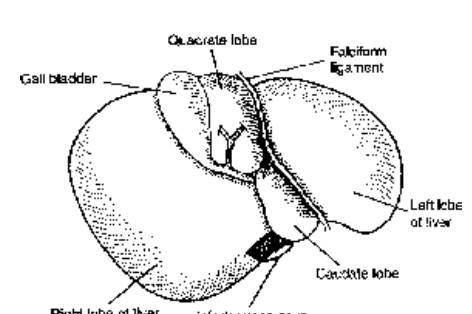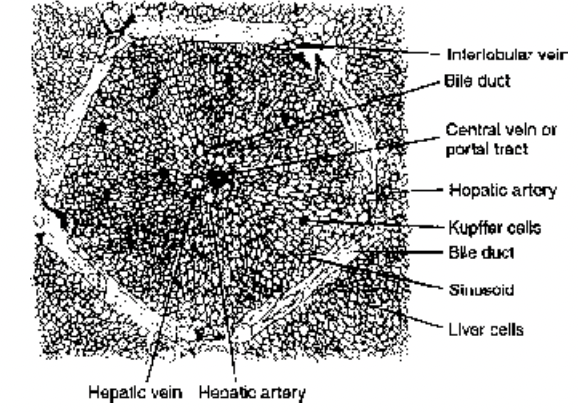Liver
Animal Nutrition of Class 11
The largest gland liver is the chemical industry of body. It acts as chemical check post as any substance or nutrient is distributed in body through liver.
It is the major homoeostatic organ to maintain the chemical balance of the body.
In some invertebrates liver and pancreas make single unit, hepatopancreas. (Eg. Prawn)
As derivative of gut it is formed as mass of endodermal epithelial cells.
Other facts
Bilirubin is formed by daily destruction of hemoglobin due to death of 1% RBC everyday.
Human liver weighs about 1.5 to 2 kg. and is divided into 3 lobes
Glisson’s capsule, connective tissue sheath around each lobule, is a characteristic feature of mammal.
Kupffer’s cells are large phagocytic cells to remove unwanted substance or foreign material from liver hence, also known as hepatic macrophages.
Hepatic capillaries arise from cell level and unite to form main hepatic duct emerging from each lobe to join bile duct (ductus choledocus) which is also joined by Cystic duct emerging from gall bladder.
Opening of the bile duct in duodenum is guarded by sphincter of Oddi.
Gall bladder is a separate part associated with liver for the storage and concentration of bile.
Many animals like horse, pigeon, rat do not have gall bladder.


Fig. Liver of man Fig. T.S. of mammalian liver
Functions :
Liver performs variety of functions like synthesis, interconversions storage, secretion of various substances as follows:
Glycogenesis : Extra glucose is converted to glycogen with the help of insulin and stored in this form either in liver or in muscles.
Glycogenolysis : Glycogen is converted into glucose when its level falls (below 80 mg/100 ml) in the blood. This is influenced by glucagon hormone.
Glucogenesis : Synthesis of glucose from other carbohydrates.
Gluconeogenesis : Synthesis of glucose / carbohydrates from protein and lipids (non carbohydrate sources)
Lipogenesis : Extra protein and carbohydrates are converted into lipid for storage in adipose connective tissue.
Deamination of protein : If protein is used for energy production, the NH2 group is removed from amino acid as NH3, the end product keto acid, enters Kreb’s cycle.
Ornithine Cycle : Chemical part of excretion, NH3 is converted into urea in a cyclic chain of reactions in which ornithine plays pivotal role. .
Cori Cycle : Lactic acid formed in muscle is converted back to glycogen.
Synthesis of substances like:
VitA from carotene.
VitD from cholesterol or ergocalciferol.
Plasma protein (Albumin, globulin, clotting proteins), heparin.
Angiotensinogen, an osmoregulatory substance in the blood.
Haemoglobin: formation of RBC in frog and embryonic mammals.
Somatomedin : a growth promoting factor also called as IGF (insulin-like growth factor)
Detoxification of Indole, skatole, cresol, phenol, alcohol, prussic acid and other toxic substances formed during digestion or obtained in food.
Excess alcoholism affects liver by overburden of work and fat deposition.
It converts alcohol to aldehyde which promotes fat deposition causes puffiness and liver cirrhosis.
Storage of Glycogen, Vitamins like VitA, VitD VitK, VitB12 and folic acid etc.; Fe and Cu.
Water, lymph and blood, (about l/5th of total blood).
By storing blood and water, liver controls the volume and viscosity (concentration) of blood.
By generating and consuming heat in different chemical reaction it acts as thermoregulatory organ.
Secretion of Bile
Bile is a yellowish watery fluid, concentrated in gall bladder, contains : 85% water; 6% organic salt of bile acids (sodium glycocholate and sodium taurocholate); 1% inorganic salt
(bicarbonate, carbonates and chlorides of Na and K); 1.5 to 2% lipid (cholesterol, lecithin); 3% mucin and bile pigments (bilirubin and biliverdin).
Extra cholesterol and bilirubin are eliminated from the body through gut.
Increase in bilirubin level beyond normal (0.1 to 0.9 mg/100 ml.) in the blood is called as jaundice. This happens if hepatic cells become sick due to viral or bacterial infection or obstruction or lesion.









